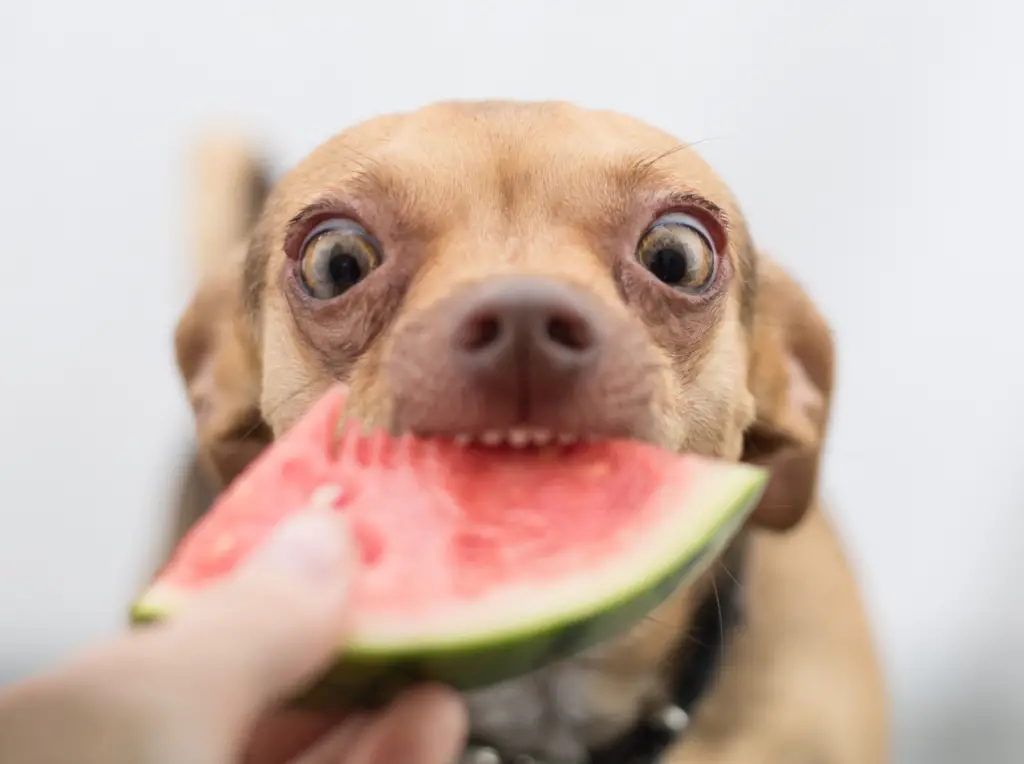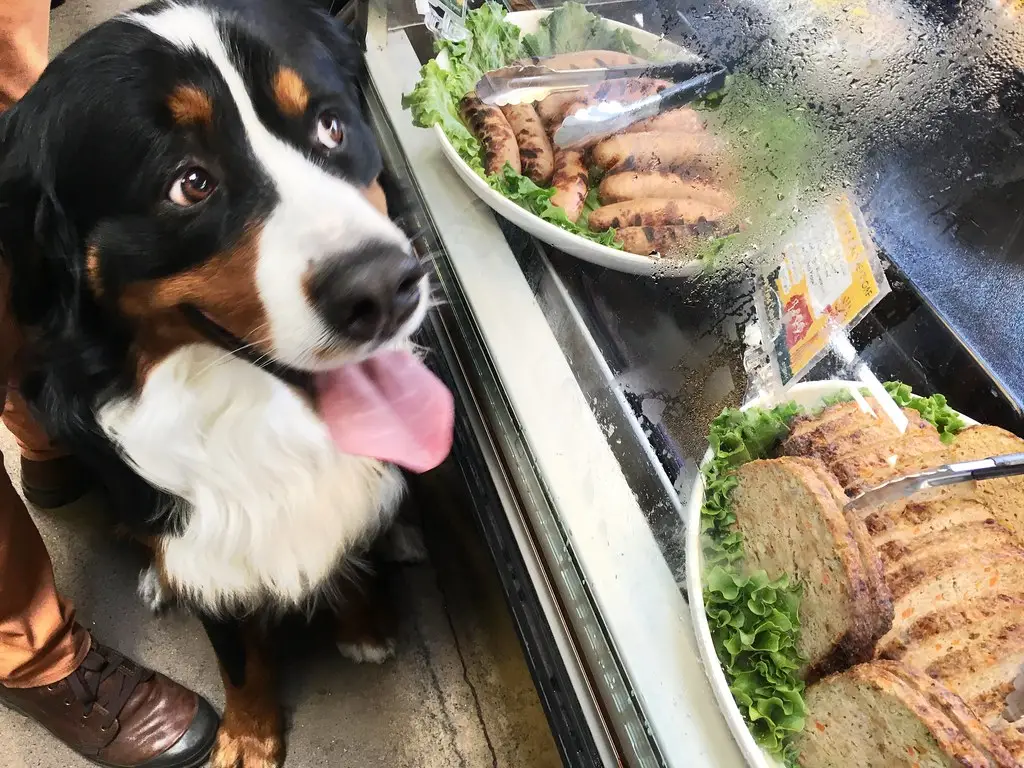1. Variety and Flavor Enhancements

Dogs, like humans, can get bored of eating the same meal every day, which can lead to disinterest in their food. People food can add variety and flavor to your dog’s meals, making mealtime more exciting for them. Simple additions like small pieces of chicken, turkey, or even mild cheese can entice even the pickiest eaters to finish their food. These foods not only provide a new taste experience but also introduce different textures and scents that may appeal to your dog’s senses. Dogs, especially older ones, may become less enthusiastic about their kibble as they age, and adding something new can encourage them to eat.
For instance, adding a spoonful of plain yogurt or cooked vegetables like the ones discussed by PetMD can give a fresh twist to their bowl and provide them with extra nutrients. Even foods like scrambled eggs or a small serving of cooked salmon can add variety while offering health benefits. Mixing in human food occasionally prevents the repetition of flavor, which can help improve their appetite and overall enjoyment of meals. This also allows you to avoid the typical “dog food” smell and might make their meals more palatable. Just be sure to stick to dog-safe, healthy options and avoid common allergens or harmful foods. In the end, feeding your dog a varied diet can improve their relationship with food and make mealtime more enjoyable.
2. Better Nutrient Absorption

Many commercial dog foods contain all the essential vitamins and minerals for your dog, but the absorption rate can vary based on the quality of the ingredients used. People food, especially whole, unprocessed foods, can sometimes provide nutrients that are easier for dogs to absorb and more bioavailable. For instance, fresh vegetables like sweet potatoes and spinach are packed with vitamins that promote overall health. When paired with their regular meals, these nutrient-dense foods can help your dog absorb important nutrients more effectively. Adding a small amount of fruit like blueberries or strawberries can provide antioxidants that boost your dog’s immune system and protect against oxidative stress. Yogurt is another example—its probiotics can help improve gut health and digestion, allowing your dog to better absorb nutrients from the food they consume.
According to the American Kennel Club, bone broth, often used in human diets, is another great addition that can provide essential minerals like calcium and magnesium, which support bone and joint health. Including more whole, fresh foods can improve your dog’s ability to utilize the nutrients in their regular food and support better overall health. Furthermore, some dogs may have food sensitivities that affect nutrient absorption, and adding natural foods can help avoid triggering those sensitivities while still providing essential nutrients. When your dog’s digestive system is healthy and working optimally, they can benefit more from everything they eat, which supports their long-term health.
3. Improved Skin and Coat Health

One of the biggest benefits of adding people food to your dog’s diet is the potential for healthier skin and a shinier coat. Many human foods are rich in omega-3 fatty acids, which are essential for maintaining healthy skin and a glossy coat. Fatty fish like salmon, sardines, or mackerel are excellent sources of these beneficial fats, which not only contribute to a shiny coat but also help alleviate common skin issues like dryness, itching, or flakiness. Omega-3s also have anti-inflammatory properties that can reduce irritation and support your dog’s immune system. Dogs with sensitive skin, allergies, or dry coats may particularly benefit from incorporating these healthy fats into their diet. Similarly, vitamin E, found in foods like leafy greens, carrots, and avocados, is another key nutrient for skin health.
According to Vetericyn Animal Wellness, vitamin E works as an antioxidant that helps repair skin cells, protect against UV damage, and keep your dog’s skin moisturized. Many high-quality dog foods contain omega-3 fatty acids, but fresh fish and natural sources of fat can provide more potent doses, often leading to quicker and more noticeable results. Including these kinds of healthy fats in your dog’s diet can help manage skin conditions and improve the overall condition of their coat. Plus, the fresh, flavorful fish is often more appealing to dogs than fish oil supplements found in some dog food. In short, supplementing their diet with omega-rich human foods can give your dog’s skin and coat a noticeable glow, while also supporting their overall health.
4. Natural Sources of Fiber

Dogs need fiber in their diet to maintain a healthy digestive system, but not all commercial dog foods provide the right amount of fiber or contain the most natural sources of it. People food can be a great way to naturally increase the fiber in your dog’s diet. For example, cooked pumpkin is an excellent source of fiber and can help with both constipation and diarrhea in dogs. Similarly, sweet potatoes and carrots offer high levels of fiber that aid digestion and promote regular bowel movements. These foods are gentle on the stomach and provide fiber without the need for processed additives. Fiber helps keep the digestive tract functioning properly by moving food through the system and preventing sluggish digestion.
Additionally, fiber-rich foods can help your dog feel fuller for longer, which is especially beneficial for dogs who are overweight or need help with portion control. According to a study published in PubMed Central, fiber also supports healthy gut bacteria, contributing to better overall digestion and nutrient absorption. Incorporating these whole, fiber-packed foods can help your dog maintain a healthy weight, prevent digestive issues, and ensure their intestines are working optimally. Because these natural sources of fiber are easily digestible, they are ideal for dogs with sensitive stomachs or those recovering from illness. Just remember to introduce fiber gradually and monitor your dog’s reaction to avoid any digestive upset.
5. Hydration Support

Hydration is a key aspect of maintaining your dog’s health, yet some dogs don’t drink enough water on their own. People food that has a high water content can help increase your dog’s hydration levels and prevent dehydration. For example, fruits like watermelon, cucumbers, and strawberries have high water content, making them a hydrating and refreshing snack for your dog. These fruits not only provide hydration but are also packed with vitamins like vitamin C and antioxidants that can support your dog’s immune system. A few slices of watermelon or cucumber can be a healthy and fun way to encourage your dog to drink more, especially during the summer months when dehydration risks are higher. Adding water-rich fruits to your dog’s diet can also improve the texture and flavor of their meals, helping to keep them hydrated without forcing them to drink extra water.
According to PetMD, incorporating water-rich foods like zucchini or celery into their meals provides a crunchy texture that many dogs enjoy. These hydrating snacks are perfect for pets who don’t drink much water or prefer a bit of flavor in their hydration. It’s important to remember, though, that not all human foods are suitable for hydration—some fruits like grapes and raisins are toxic to dogs, so it’s crucial to stick to safe options. Overall, adding these hydrating foods can keep your dog’s fluid levels up and their body functioning properly.
6. Customizable Diet for Specific Health Needs

Every dog is unique, and sometimes people food can offer a more tailored solution to your dog’s health needs than commercial dog food. For example, if your dog is recovering from surgery or illness, plain boiled chicken and rice are gentle on their digestive systems and provide easily digestible protein and carbohydrates. Dogs with joint issues can benefit from the nutrients found in bone broth, which is rich in collagen and can help support joint health. Similarly, dogs with food allergies or sensitivities may find that fresh, home-prepared meals are easier on their system compared to processed dog foods filled with fillers and preservatives. Cooking your dog’s meals at home with human-grade ingredients allows you to control exactly what goes into their diet, which can be particularly important for pets with special dietary requirements.
If your dog is struggling with weight management, you can use lean proteins like turkey or chicken breast and low-calorie vegetables to help them shed extra pounds. With a customized diet, you can experiment with ingredients to find the right combination that meets your dog’s specific needs, whether it’s supporting their immune system, enhancing digestion, or managing a health condition. Always consult with your veterinarian before changing your dog’s diet, especially if they have specific medical concerns, to ensure you’re meeting their nutritional requirements.
7. Boosting Appetite in Ill or Aging Dogs

Older dogs or those dealing with health problems may lose their appetite, which can lead to weight loss and malnutrition. People food can be an effective way to encourage your dog to eat when they’re feeling under the weather or just not as enthusiastic about their regular meals. Soft, easy-to-digest foods like scrambled eggs or mashed sweet potatoes can be gentle on their stomachs and provide the nutrition they need without overwhelming them. These types of foods are often more flavorful and aromatic than kibble, making them more appealing to a dog that might be experiencing a reduced sense of smell or taste due to illness or age.
For dogs with dental issues, soft human foods can also be easier to chew than kibble. In these cases, adding small amounts of chicken broth or plain cooked turkey can also make meals more enticing, ensuring your dog gets the nutrients they need during a time when they might otherwise refuse to eat. Additionally, human food often offers a more fragrant aroma, which can entice dogs who are struggling with appetite loss. Be sure to avoid overfeeding or giving them foods that are too rich, as it could lead to digestive upset. If your dog is consistently refusing food, it’s essential to consult with a veterinarian to rule out any underlying health conditions. Boosting their appetite with people food should be used as a temporary solution while you work with your vet on a more permanent strategy.
8. Fewer Additives and Preservatives

Many commercial dog foods contain preservatives, artificial colors, and flavorings to enhance shelf life and taste. While these additives are generally considered safe for most dogs, some pets may be sensitive to them. People food, especially fresh, home-cooked meals, tends to have fewer artificial ingredients, giving you more control over what your dog consumes. For example, cooking a simple meal of lean chicken, rice, and vegetables eliminates the need for preservatives or additives often found in processed pet foods. Many high-quality, natural ingredients in human food are free of synthetic chemicals, which can be particularly beneficial for dogs with allergies or sensitivities.
Additionally, the fewer artificial ingredients in a dog’s diet, the less likely they are to experience adverse reactions, such as skin rashes or gastrointestinal issues. While commercial dog foods aim to meet nutritional requirements, some owners prefer the peace of mind that comes with feeding their dogs home-cooked meals that they can prepare themselves. However, it’s still important to ensure that the people food you offer is nutritionally balanced to meet your dog’s needs. If you’re making homemade food for your dog, working with a veterinarian or pet nutritionist to create a balanced meal plan is highly recommended.


